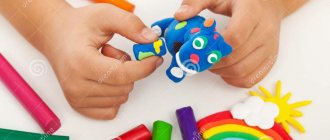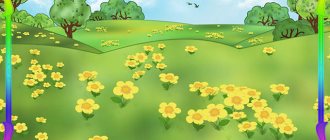Spatial representation in children
Children must be able to navigate in space: on the street, in a room, on a piece of paper, in the movement of direction, in time. Toss the ball with your child, explaining that it flies up and falls down. Plant 3 toys in order. In the middle, for example, is a bunny. Let the children explain who is sitting in front, behind, left, right, etc. It is advisable to swap toys. During breakfast, explain to the children that it is morning. Also at lunch or during dinner. Talk to your children about the night. During art lessons, have children draw paths and explain where they lead: forward, left, right.
Classes in kindergartens about space develop children’s imagination, attention, fine motor skills, and form the ability to navigate both in a group and on the street.
Study of geometric shapes
All objects that surround the child have their own shape. Children remember geometric shapes best through play. Are you playing ball? Explain to your baby that he is round. Looking out the window? Say it's square. Thus, you also study FEMP in the second junior group.
The teacher or parents can draw geometric shapes on a sheet of paper and cut out shapes from cardboard for them. Let the child put them on the drawing. Rest assured, kids will find the right figure in a matter of seconds. They find learning very easy. Children can be shown a picture with: a circle, a plate, a piano, a cup. Ask them to find round shaped objects. Children love this FEMP activity very much, and therefore will not remain indifferent to it.
Idea of size
The plan should indicate how to compare and measure quantities. Take the nesting dolls and explain to the kids where the smallest and largest are. It is not advisable to compare 3 or more objects at once; children will quickly get confused. For starters, two toys are enough. The size can be compared not only by height, but also by length. These can be bright multi-colored ribbons (long – green, short – pink). Also by thickness (the doll is thin, the bunny is fat).
In order for children to be interested in learning about size, you can tell them a story: “The prince and princess are going to a carnival, they need beautiful belts, here are ribbons, short and long, who should we tie them to?” Two kids come out and tie the knot. After a while, the teacher says: “Oh, the prince and princess want to exchange belts, who will help them?” Two other kids come out. As a result, the ribbons can be placed one on top of the other and show how to figure out where the short and long are. In this way, children develop fine motor skills of their fingers and the idea of size.
Techniques for forming mathematical representations
To form ideas, special preparation is carried out. The main technique that is used in almost all activities is play. This is important for a preschooler. In addition, the teacher can use additional methods:
- oral-verbal;
- visual;
- practice.
Types and use of interactive technologies in preschool education
Methods are selected depending on the end goal or task. Also, when selecting, the characteristics of the group of children are taken into account. The chosen methodology also depends on the topic. Some methods are suitable for some topics, and others are suitable for others. It is common to mix methods. Game methods can be subject-oriented, plot-oriented or follow a script.
Important! The best results come from practice and playful learning. To do this, objects and actions with them are used. Visual memory develops.
The form for submitting assignments can be any. If necessary, the teacher can choose an individual form. An exercise to consolidate knowledge is selected based on the topic being studied. In most cases, group work is used, as it saves the teacher’s time, teaches kids cohesion and the ability to work in a team, which is a positive thing.
When using the game method, tasks should develop mathematical thinking and teach the child to master the data obtained in previous games. Games make it easy to explain space and size, colors, sizes.
It is recommended to reserve the visual method for those cases when you need to explain a topic that is easily demonstrated. For example, the lesson is about length and height. Visually, the child will immediately be able to distinguish long or short, tall or short. Concepts such as “left”, “right” and “center” require mandatory demonstration.
Division into groups
Of the oral methods, the most popular are explanations or instructions. The task is given orally. The child learns to listen to the teacher. Auditory memory and imagination develop. At the same time, information must be presented in portions. If too much is said verbally, the baby will not remember and will lose interest in the process.
To consolidate, one of the verbal forms is used - questions. Only by asking the child and listening to his answer, you can conclude whether he understood the topic or not. This method helps develop speech and communication skills. Each time the preschooler will answer faster and more correctly.
Note! A small quick survey is conducted at the end of each lesson. If the child does not understand, you should have a conversation and convey the necessary information to the child.
Advice for parents and educators
There is no need to scold your child if something doesn’t work out for him. Or he forgot the name of the shape or color. You may disappoint him in his studies. If the baby cannot cope with something, help him tenderly, with a smile on his face. You will see how eagerly he wants to prove to others that he can do anything. The most important thing in pedagogy is to be patient. What is elementary for adults seems very difficult for a child. Put yourself in the baby's shoes: how will you feel if you are yelled at? Of course, anger. The baby feels the same, but he can’t express much. Be a kind and patient teacher, only then will you be able to achieve the desired results.
Teaching techniques and methods
Mathematics classes in the 2nd junior group should be visual and effective. Children acquire any new knowledge through direct perception, that is, when they follow all the actions of the teacher and themselves repeat the same actions with handout didactic material. The teacher-educator needs to carefully think through each lesson, all new concepts characterizing the subject, first the teacher himself pronounces several times during the lesson and only then asks the children to repeat.
In addition, we must not forget that this age of learning everything new is based on emotional perception. And if you don’t interest your child from the first minutes of the lesson, then it will be in vain. To do this, children's math classes most often begin with surprise moments:
- the appearance of a toy,
- unexpected guests,
- chest with a secret.
The teacher-educator needs to keep the children's attention throughout the entire lesson. To do this, the technique of changing activities is used. The subjects with which the child will work must already be previously familiar to him, otherwise he will first study them the way he needs and will miss all the material offered by the teacher.
Progress of the lesson
At the preparatory stage, a lesson outline is drawn up and the necessary materials are prepared. If necessary, dummies are used. A selection of riddles, fairy tales and musical accompaniment is carried out in advance.
It is necessary to choose the form and methodology of conducting the lesson. For important topics, you can use an open lesson that will be attended by a guest. If parents of preschool children are invited as guests, the children will be more active.
A fairy tale or cartoon is chosen as the basis on which the game will be based. The chosen character should be loved by children and motivate them.
Mini blitz survey to consolidate knowledge
The teacher announces the essence and conditions of the game, passing off the character as the initiator of the game. Distributes necessary items or cards and all props. For example, if preschoolers are learning to count, then they are given counting sticks or other objects for counting. Riddles, stories and poems are designed to help make the task easier. Thanks to them, children will better understand the task.
Non-traditional drawing technique for the middle group of kindergarten
Important! After the main part, you can do physical exercises accompanied by music. After it, the children will relax and throw out the accumulated tension.
In conclusion, what has been learned is consolidated and the results are summed up. The guys need to say words of praise and emphasize that they are great. You can close the topic with the help of fairy tales, poems, music and songs.


